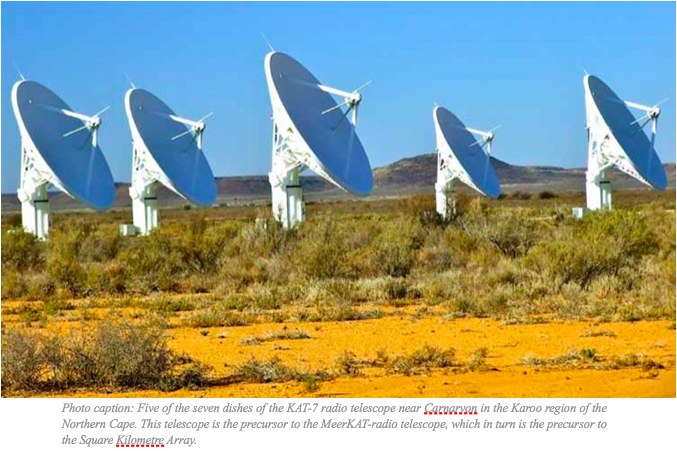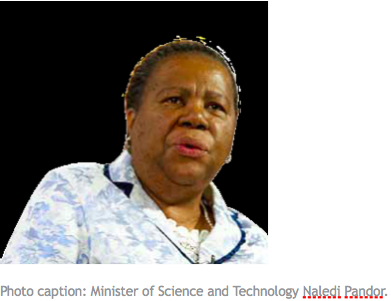Stephen Timm


South Africa is set for a massive boost in science with the recent announcement that the country – together with eight African partner nations – will host the majority of the Square Kilometre Array (SKA) telescope project.
Ready for the world’s most powerful radio telescope, South Africa with partners Botswana, Ghana, Kenya, Madagascar, Mauritius, Mozambique, Namibia and Zambia, will host 70 per cent of the SKA project, while New Zealand and Australia will host the remainder.
The telescope, which will be fully operational in 2024, combines thousands of satellite dishes and antennae spread out over thou- sands of square kilometres. This enables it to look deep into space – allowing astronomers to explore the origins of the universe and detect signs of extraterrestrial life.
SKA brings with it a number of benefits, including increased regional collaboration among African countries and increased interest in astronomy.
A cheerful Minister of Science and Technology Naledi Pandor said the project would change the profile for Africa.
“It means if I as an astronomy scientist wanted to probe the galaxy far more deeply than has ever been probed before, … I would have to come to Africa… So, suddenly Africa becomes a destination for science, rather than a place to which you come to extract minerals and take them somewhere else to have value added to them,” said Pandor.
She said more than 500 research groups had already placed bookings to use South Africa’s SKA precursor telescope, MeerKAT, from 2016.
Careers in science
The Minister added that the Department of Science and Technology planned to popularise SKA in schools by strengthening the existing SKA schools outreach programme, which helps students develop careers in science.
Since 2005, a total of 292 students have benefited from SKASA bursaries and scholarships to develop future scientists and engineers.
“We believe getting the SKA, just as with getting the World Cup, is going to cause massive incentive, excitement and interest in the sciences and maths among young people. But unlike the World Cup, this is a 50-year project, not a few weeks in winter,” said Minister Pandor.
South Africa will also be rolling out infrastructure, including accommodation for scientists who visit the site. In addition, SKA South Africa is expected to award a number of tenders this year to develop roads, power and buildings in the Northern Cape.
MeerKAT
Minister Pandor said the tender for Meer- KAT – a precursor to SKA – had been issued and she expected the first of the 64 MeerKAT dishes to be up in 2013, with the remainder in place three years later. These will be joined by 190 mid-frequency dish-shaped antennae.
In the second phase, beginning in 2016, about 3 000 mid-frequency dishes will be built, along with a large number of flat mid- frequency antennas. The majority of these will go up in the Northern Cape.
Funding for the SKA will come from all the members of the SKA Organisation – which has a collective fund of 1,5 billion euros (R15,8 billion). The current members of the SKA Organisation are Australia, Canada, China, Italy, New Zealand, South Africa, the Netherlands and the United Kingdom.
South Africa has spent about R2 billion to develop MeerKAT; this includes seven dishes that make up KAT7 at Carnarvon in the Northern Cape.
Commenting about the possibility that *fracking may disrupt the SKA project, Minister Pandor said the Astronomy Geographic Advantage Act of 2007 allowed the Minister of Science and Technology to prevent any activity with those areas designated for astronomy, within a 180km radius.
“So should it be necessary we will use that Act,” said Minister Pandor, adding that her department had just published regulations on how the act would be used.
Stars in our eyes
Minister Pandor said the bidding process against the Australia/New Zealand team had been very competitive. One of the greatest challenges had been convincing the SKA Organisation of Africa’s capability.
“Often it wasn’t questioning us on ‘is this good equipment; does it work?’ It was ‘can Africa really do it?’’ said Minister Pandor. However she believes Africa had shown that we can do it.
“Everything that was asked for, we met the deadlines, all of the information we were able to provide – we over-informed. Because we had done our homework and had taken this on, as a project we had regarded as a critical project… for South Africa and the African continent.”
In an editorial comment in Public Sector Manager magazine published by Government Communications, Minister Pandor wrote: “… We are justifiably proud of our scientists, of our country and our continent. This is an iconic project that will no doubt match the spirit and efficiency with which our country hosted the FIFA World Cup in 2010. The stars in our eyes are a reality.”
* Fracking, which is short for hydraulic fracturing, is the process of extracting natural gass from rock layers deep within the earth. It entails creating fractures in rocks and rock formations by injecting highly pressurised fluid into cracks to force them further open. The larger fractures allow more oil and gas to flow out of the formation and into the wellbore, from where it can be extracted.



 Facebook
Facebook Twitter
Twitter WhatsApp
WhatsApp